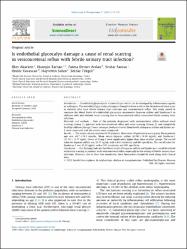| dc.contributor.author | Akarken, İlker | |
| dc.contributor.author | Tarhan, Hüseyin | |
| dc.contributor.author | Arslan, Fatma Demet | |
| dc.contributor.author | Sarıtaş, Serdar | |
| dc.contributor.author | Yavaşcan, Önder | |
| dc.contributor.author | Şahin, Hayrettin | |
| dc.contributor.author | Tekgül, Serdar | |
| dc.date.accessioned | 2021-06-24T11:24:49Z | |
| dc.date.available | 2021-06-24T11:24:49Z | |
| dc.date.issued | 2021 | en_US |
| dc.identifier.citation | Akarken, İ., Tarhan, H., Arslan, F. D., Sarıtaş, S., Yavaşcan, Ö., Şahin, H. ... Tekgül, S. (2021). Is endothelial glycocalyx damage a cause of renal scarring in vesicoureteral reflux with febrile urinary tract infection? Nephrologie et Therapeutique, 17(3), 175-179. https://dx.doi.org/10.1016/j.nephro.2021.01.003 | en_US |
| dc.identifier.issn | 1769-7255 | |
| dc.identifier.issn | 1872-9177 | |
| dc.identifier.uri | https://dx.doi.org/10.1016/j.nephro.2021.01.003 | |
| dc.identifier.uri | https://hdl.handle.net/20.500.12511/7304 | |
| dc.description.abstract | Introduction. - Endothelial glycocalyx is a luminal layer which can be damaged by inflammatory agents or pathogens. The endothelial glycocalyx damage is thought to have a role in the formation of renal scars in children who have febrile urinary tract infection and vesicoureteral reflux. This study aimed to compare the blood levels of endothelial glycocalyx components heparan sulfate and Syndecan-1 in children with and without renal scarring due to vesicoureteral reflux-associated febrile urinary tract infection. Materials and methods. - Data of the patients diagnosed with vesicoureteral reflux without renal scarring (Group 1), patients with vesicoureteral reflux and renal scarring (Group 2), and completely healthy children (Group 3) were retrospectively reviewed. Blood levels of heparan sulfate and Syndecan-1 were measured and the results were compared. Results. - The entire cohort consisted of 90 patients; there were 30 patients in each group. Mean patient age was 49.7 +/- 18.0 months. Mean serum heparan sulfate (42.90 +/- 18.90 ng/mL) and Syndecan-1 (37.59 +/- 13.77 ng/mL) levels of Group 2 were significantly higher than those of other groups. The cut-off value for heparan sulfate was 35.17 ng/mL, with a 63% sensitivity and 86% specificity. The cut-off value for Syndecan-1 was 29.99 ng/mL with a 70% sensitivity and 80% specificity. Conclusion. - Our findings indicate that blood levels of heparan sulfate and Syndecan-1 could be related with renal scarring in patients with vesicoureteral reflux, especially in the setting of febrile urinary tract infection. However, due to their low sensitivity, these biomarkers should be used along with clinical data. | en_US |
| dc.language.iso | eng | en_US |
| dc.publisher | Elsevier Masson s.r.l. | en_US |
| dc.rights | info:eu-repo/semantics/embargoedAccess | en_US |
| dc.subject | Vesicoureteral Reflux | en_US |
| dc.subject | Endothelial Glycocalyx | en_US |
| dc.subject | Heparan Sulfate | en_US |
| dc.subject | Syndecan-1 | en_US |
| dc.subject | Urinary Tract Infection | en_US |
| dc.title | Is endothelial glycocalyx damage a cause of renal scarring in vesicoureteral reflux with febrile urinary tract infection? | en_US |
| dc.type | article | en_US |
| dc.relation.ispartof | Nephrologie et Therapeutique | en_US |
| dc.department | İstanbul Medipol Üniversitesi, Tıp Fakültesi, Dahili Tıp Bilimleri Bölümü, Çocuk Sağlığı ve Hastalıkları Ana Bilim Dalı | en_US |
| dc.identifier.volume | 17 | en_US |
| dc.identifier.issue | 3 | en_US |
| dc.identifier.startpage | 175 | en_US |
| dc.identifier.endpage | 179 | en_US |
| dc.relation.publicationcategory | Makale - Uluslararası Hakemli Dergi - Kurum Öğretim Elemanı | en_US |
| dc.identifier.doi | 10.1016/j.nephro.2021.01.003 | en_US |
| dc.identifier.wosquality | Q4 | en_US |
| dc.identifier.scopusquality | Q3 | en_US |


















